Helianthus L. (Asteraceae)
Helianthus comprises twenty-six species in North Carolina, including nine introduced taxa (i.e., H. annuus, H. argophyllus, H. grosseserratus, H. laetiflorus, H. maximiliani, H. mollis, H. petiolaris, and H. tuberosus). Only Helianthus schweinitzii is federally listed (Fed E, S3 G3). Helianthus floridanus (S1 G3G4) is currently state listed as threatened (note: North Carolina populations referred to this name have been recently recognized as a distinct species: H. waccamawensis). Helianthus laevigatus is listed as SC-V (S3 G4). Helianthus occidentalis var. dowellianus is state historic (SC-H, SX G5T5).
North Carolina species of Helianthus can be divided into (1) annuals or perennials, and (2) species with basally disposed leaves or those with well-developed cauline leaves. As the listed species are all perennials and exhibit cauline leaves, no key is provided for the annuals or those species with basally disposed leaves (see Weakley [2010] for complete keys to these groups). Note that the color of the disk flowers can be variable within species and some, such as H. angustifolius, H. floridanus, and H. simulans, will exhibit red, yellow, or mixed red-yellow disk flowers.
Federally listed taxon—
Helianthus schweinitzii (Fed E, State E | S3 G3)
Habitat. Thought to occur historically in prairie-like habitats or Quercus stellata-Q. marilandica savannas maintained by fire; now often associated with roadsides, powerline cuts, open woodlands
Range. Endemic to the Piedmont of the Carolinas.
Additional resources. NHP | Recovery plan
Key to Helianthus in North Carolina
Key adapted from Schilling (2006 [FNA]) and Weakley (2008). Photos by Krings, unless otherwise indicated. Line drawings from Britton & Brown (1913). Maps courtesy of USDA PLANTS and the North Carolina Natural Heritage Program.
1. Leaves basally disposed, basal leaves persistent at anthesis [H. atrorubens, H. heterophyllus, H. longifolius, H. occidentalis var. dowellianus]...see Schilling (2006) or Weakley (2010)
1’. Leaves cauline, stem leafy for its length, basal leaves often lacking at anthesis...2.
2. Plant annual, tap-rooted (rarely surving to second year) [H. annuus, H. argophyllus, H. debilis ssp. cucumerifolius, H. petiolaris, H. porteri]...see Schilling (2006) or Weakley (2010)
2’. Plant perennial, rhizomatous and/or producing tubers...3.
3. Plant rhizomatous, but also producing tubers...4.
4. Tubers narrow, fusiform; leaves subsessile, petioles < 1 cm long...H. schweinitzii* 
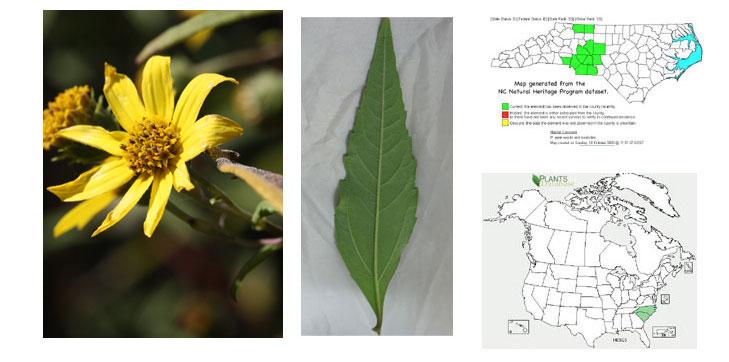

Habit of Helianthus schweinitzii (Photo: Krings)

Root of Helianthus schweinitzii (Photo: Krings)

Stem of Helianthus schweinitzii (Photo: Krings)

Leaf of Helianthus schweinitzii (Photo: Krings)

Leaf underside of Helianthus schweinitzii (Photo: Krings)

Helianthus schweinitzii (Photo: Krings)

Helianthus schweinitzii (Photo: Krings)
Helianthus schweinitzii*
(rare [Fed E, S3 G3]; roadsides, powerline cuts, dry woodlands or “Piedmont prairies”; Pd; late summer to fall)
4'. Tubers broad, potato-like; petioles = or > than 2 cm long...H. tuberosus 
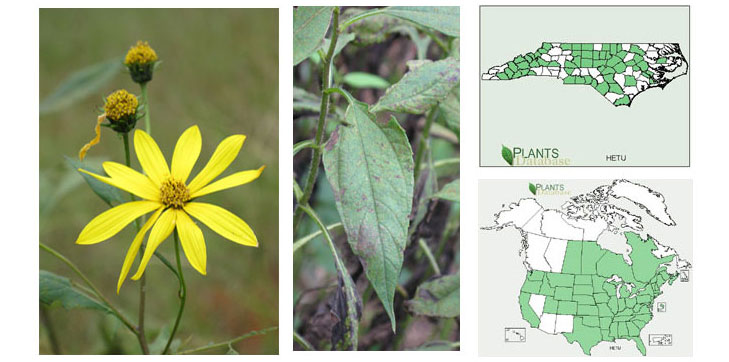 Helianthus tuberosus
Helianthus tuberosus
(common [introduced]; roadsides, disturbed areas; Mt, Pd, CP)
3'. Plant rhizomatous only, not producing tubers...5.
5. Stems below the capitulescence glabrous or nearly so, sometimes glaucous; phyllaries usually not gland-dotted...6.
6. Abaxial leaf surface glaucous, glabrate or glabrous, not gland-dotted...7.
7. Phyllaries 12–15, laminae 12–14 mm long...H. glaucophyllus 
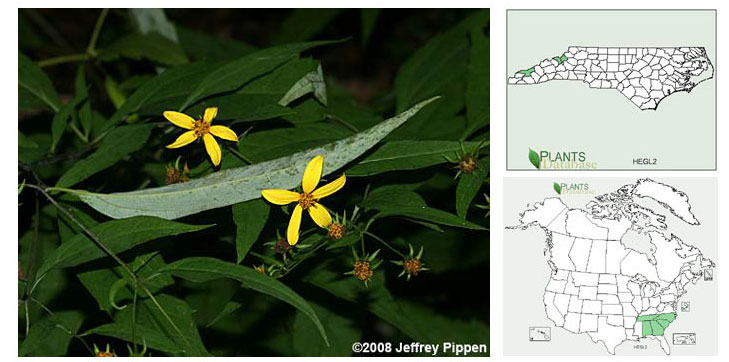

Glaucous stem of Helianthus glaucophyllus (Photo: Krings)

Leaf of Helianthus glaucophyllus (Photo: Krings)

Leaf base of Helianthus glaucophyllus (Photo: Krings)

Phyllaries of Helianthus glaucophyllus (Photo: Krings)

Phyllaries of Helianthus glaucophyllus (Photo: Krings)

Head of Helianthus glaucophyllus (Photo: Krings)

Head of Helianthus glaucophyllus (Photo: Krings)
Helianthus glaucophyllus
(rare [NC Watch List]; roadbanks, moist forests, woodlands, and woodland edges, mostly at 1000–1500 m elev.; Mt)
7'. Phyllaries 23–28, laminae 15–20 mm long...H. laevigatus 
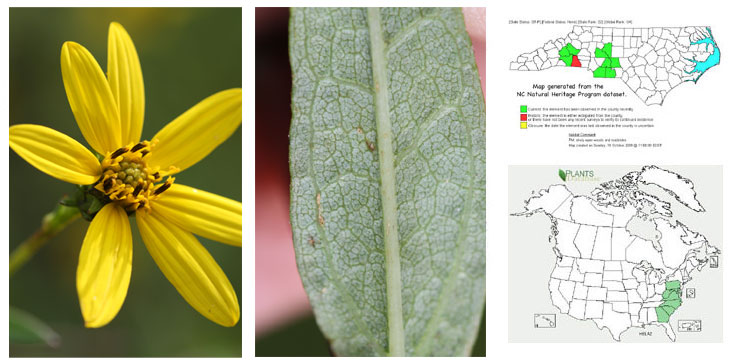

Habit of Helianthus laevigatus (Photo: Krings)

Stem and node of Helianthus laevigatus (Photo: Krings)

Leaf undersurface of Helianthus laevigatus (Photo: Krings)

Leaf undersurface of Helianthus laevigatus (Photo: Krings)

Involucre of Helianthus laevigatus (Photo: Krings)

Flowers of Helianthus laevigatus (Photo: Krings)

Ray undersurface Helianthus laevigatus (Photo: Krings)
Helianthus laevigatus
(rare [State SC-V, S3 G4]; roadbanks, powerline cuts, and open woodlands, essentially limited to the slate belt in NC, where disjunct from its primarily Va and WVa distr; Mt, Pd)
6'. Abaxial leaf surface not glaucous, pubescent, gland-dotted...8.
8. Rays few (usually 5 or 8); involucres 9 mm wide or less...H. microcephalus 


Habit of Helianthus microcephalus (Photo: Krings)

Stem and leaf of Helianthus microcephalus (Photo: Krings)

Leaf of Helianthus microcephalus (Photo: Krings)

Stam of Helianthus microcephalus (Photo: Krings)

Helianthus microcephalus (Photo: Krings)

Helianthus microcephalus (Photo: Krings)

Helianthus microcephalus (Photo: Krings)
Helianthus microcephalus
(common, except rare in CP; roadbanks and dry woodlands; Mt, Pd, CP)
8’. Rays typically 10 or more (in larger heads); involucres usually > 9 mm broad...9.
9. Leaves sessile, bases rounded to cordate, trinerved from the base...H. divaricatus 
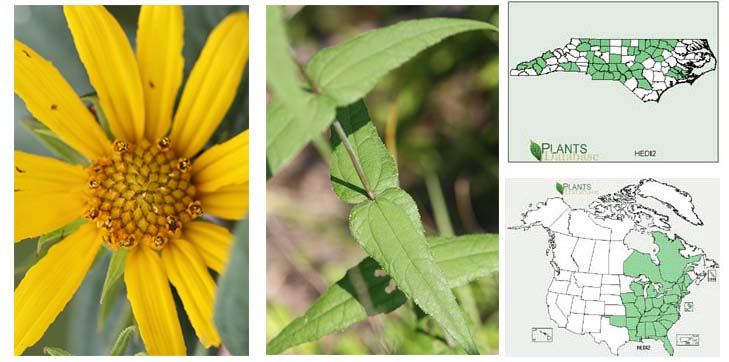

Habit of Helianthus divaricatus (Photo: Krings)

Leaves of Helianthus divaricatus (Photo: Krings)

Leaves of Helianthus divaricatus (Photo: Krings)

Leaves of Helianthus divaricatus; note glabrous stem (Photo: Krings)

Flowers of Helianthus divaricatus (Photo: Krings)

Phyllaries of Helianthus divaricatus (Photo: Krings)

Flowers of Helianthus divaricatus (Photo: Krings)
Helianthus divaricatus
(common, except rare in CP; moist to dry forests and edges; Mt, Pd, CP)
9’. Leaves sessile to petiolate, bases narrower, triplinerved...10.
10. Anther appendages yellow...H. grosseserratus 


Habit of Helianthus grosserratus (Photo: Krings)

Leaf of Helianthus grosserratus (Photo: Krings)

Leaf of Helianthus grosserratus (Photo: Krings)

Leaf base of Helianthus grosserratus (Photo: Krings)

Capitulescence of Helianthus grosserratus (Photo: Krings)

Head of Helianthus grosserratus (Photo: Krings)

Phyllaries of Helianthus grosserratus (Photo: Krings)
Helianthus grosseserratus
(rare [introduced]; disturbed areas; Mt, Pd)
10’. Anther appendages dark or reddish-brown...11.
11. Phyllaries equal to or slightly exceeding disk, apices acute; leaves moderately serrate to entire,
abaxial surface usually densely gland-dotted; petioles 1–3 cm long...H. strumosus 
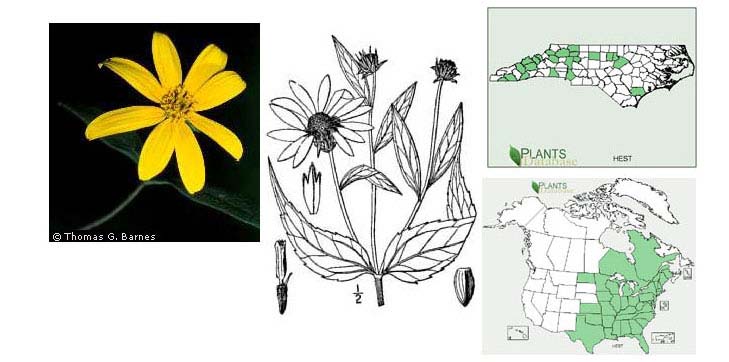 Helianthus strumosus
Helianthus strumosus
(common, except rare in CP; roadsides and woodlands; Mt, Pd, CP)
11’. Longer phyllaries usually exceeding disk by half their length or more, apices acuminate; larger leaves
moderately to notably serrate, abaxial surface sparsely gland-dotted; petioles 2–5 cm long...H. decapetalus 
 Helianthus decapetalus
Helianthus decapetalus
(common, except rare in CP; moist forests and woodlands; Mt, Pd, CP)
5’. Stems pubescent throughout, not glaucous; phyllaries gland-dotted, except not so in H. hirsutus and H. giganteus...12.
12. Leaves sessile, cordate...H. mollis 
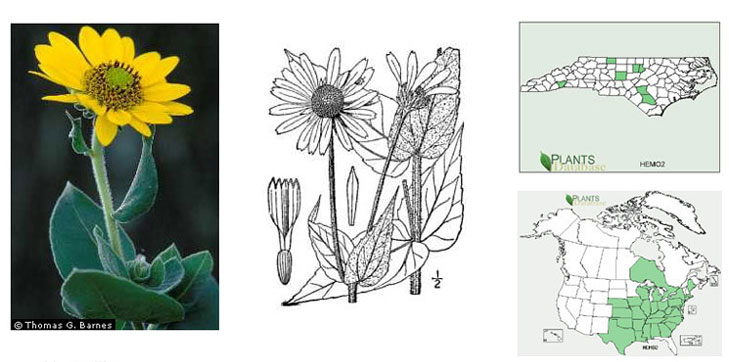

Habit of Helianthus mollis (Photo: Krings)

Stem base of Helianthus mollis (Photo: Krings)

Stem of Helianthus mollis (Photo: Krings)

Leaves of Helianthus mollis (Photo: Krings)

Capitulescence of Helianthus mollis (Photo: Krings)

Capitulescence of Helianthus mollis (Photo: Krings)

Capitulescence of Helianthus mollis (Photo: Krings)
Helianthus mollis (rare [introduced]; disturbed areas; Mt, Pd, CP)
12’. Leaves petiolate or sessile, but not cordate...13.
13. Phyllaries attenuate, squarrose to reflexed, abaxial surface densely gland-dotted (at least apically)...H. resinosus 
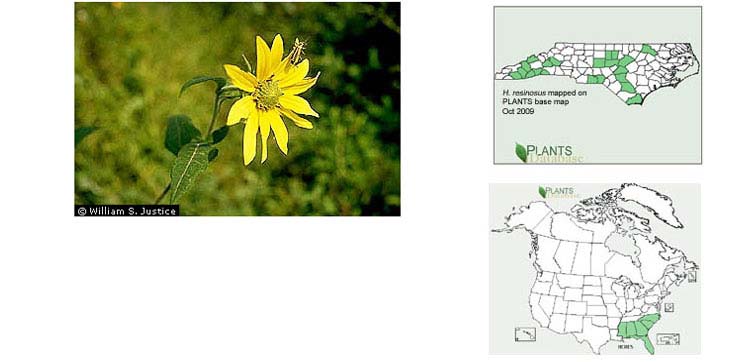

Habit of Helianthus resinosus (Photo: Krings)

Stem of Helianthus resinosus (Photo: Krings)

Leaves of Helianthus resinosus (Photo: Krings)

Leaves of Helianthus resinosus (Photo: Krings)

Capitulescence of Helianthus resinosus (Photo: Krings)

Capitulescence of Helianthus resinosus (Photo: Krings)

Phyllaries of Helianthus resinosus (Photo: Krings)
Helianthus resinosus
(uncommon; roadsides and woodlands; Mt, Pd, CP)
13’. Phyllaries acute to attenuate, not reflexed (or if so [H. giganteus], then not gland-dotted], abaxial surface sometimes gland-dotted...14.
14. Leaves usually 1-nerved, conduplicate, margins entire; inflorescence in spiciform or racemiform arrays...H. maximiliani 
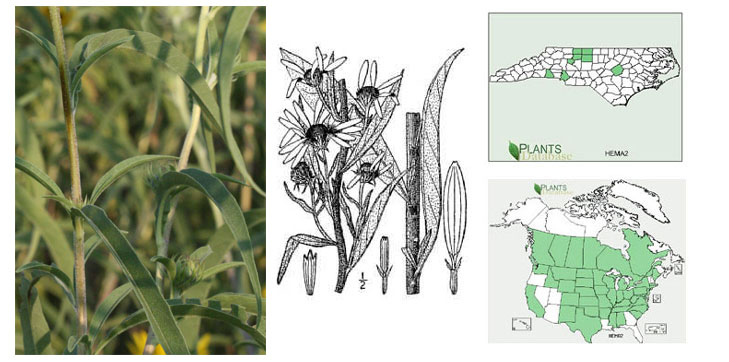

Habit of Helianthus maximiliani (Photo: Krings)

Habit of Helianthus maximiliani (Photo: Krings)

Conduplicate leaf of Helianthus maximiliani (Photo: Krings)

Flowers of Helianthus maximiliani (Photo: Krings)

Flowers of Helianthus maximiliani (Photo: Krings)

Flowers of Helianthus maximiliani (Photo: Krings)

Phyllaries of Helianthus maximiliani (Photo: Krings)
Helianthus maximiliani (uncommon [introduced]; roadsides and disturbed areas; Mt, Pd, CP)
14’. Leaves triplinerved, not conduplicate; inflorescence more or less in corymbiform arrays...15.
15. Phyllaries usually appressed, strongly unequal...H. x laetiflorus 
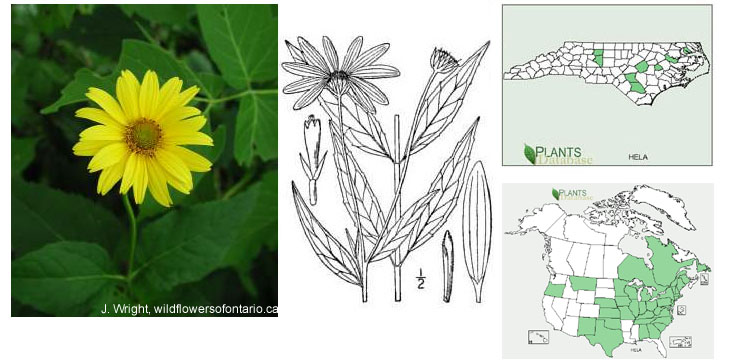 Helianthus x laetiflorus
Helianthus x laetiflorus
(uncommon [introduced]; disturbed areas; Pd, CP)
15’. Phyllaries usually loose or spreading, more or less subequal...16.
16. Leaves truncate to broadly rounded at base, shortly but distinctly petiolate; abaxial ligule surface gland-dotted...H. hirsutus 
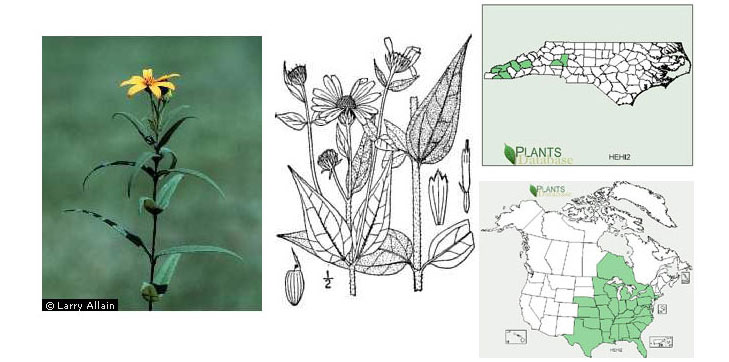

Habit of Helianthus hirsutus (Photo: Krings)

Stem of Helianthus hirsutus (Photo: Krings)

Leaves of Helianthus hirsutus (Photo: Krings)

Leaf base of Helianthus hirsutus; note short petiole (Photo: Krings)

Capitulescence of Helianthus hirsutus (Photo: Krings)

Phyllaries of Helianthus hirsutus (Photo: Krings)

Flowers of Helianthus hirsutus (Photo: Krings)
Helianthus hirsutus (uncommon; woodlands and open places; Mt, Pd)
16’. Leaves cuneate to attenuate, gradually narrowing to base, sessile to petiolate; abaxial ligule surface gland-dotted or not (H. giganteus)...17.
17. Abaxial ligule surface not gland-dotted; leaves not strongly revolute...H. giganteus 
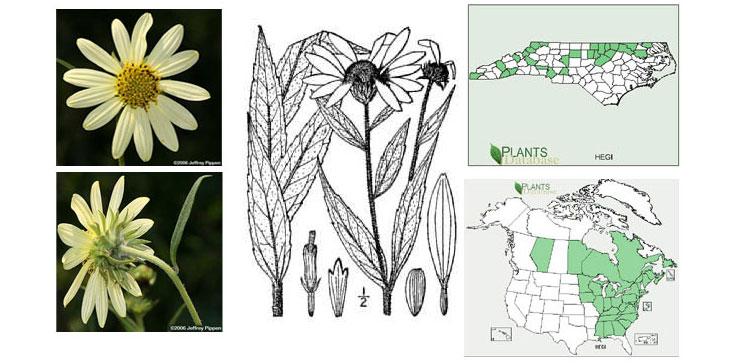

Habit of Helianthus giganteus (Photo: Krings)

Habit of Helianthus giganteus (Photo: Krings)

Leaf of Helianthus giganteus (Photo: Krings)

Leaf of Helianthus giganteus (Photo: Krings)

Flower of Helianthus giganteus (Photo: Krings)

Helianthus giganteus (Photo: Krings)

Helianthus giganteus (Photo: Krings)
Helianthus giganteus (common; roadsides, ditches, moist edges; Mt, Pd, CP)
17’. Abaxial ligule surface usually gland-dotted; leaves usually revolute...18.
18. Phyllaries appressed, ovate to broadly oblong, apex obtuse to acute...H. waccamawensis 
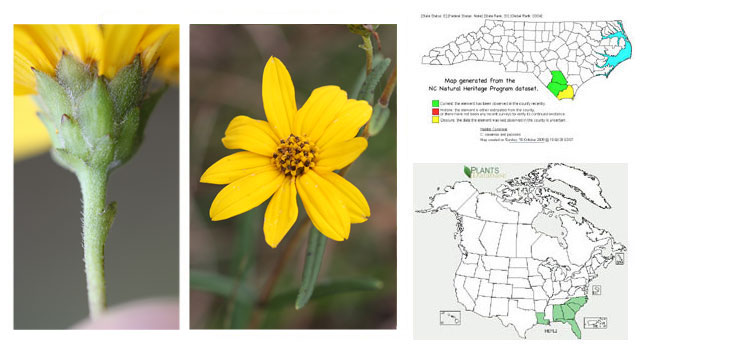

Habit of Helianthus waccamawensis (Photo: Krings)

Few-flowered inflorescence of Helianthus waccamawensis (Photo: Krings)

Ray and disc flowers of Helianthus waccamawensis (Photo: Krings)

Phyllaries of Helianthus waccamawensis (Photo: Krings)

Distal cauline leaves ofHelianthus waccamawensis (Photo: Krings; units metric)

Basal cauline leaf of Helianthus waccamawensis (Photo: Krings; units metric)

Phyllaries of Helianthus waccamawensis (top; appressed) and H. angustifolius (bottom; spreading) (Photo: Krings)
Helianthus waccamawensis
(rare[State T, S1 G3G4 (as
H. floridanus)]; wet savannas and pocosin ecotones; CP) - While still "listed" under
H. floridanus by the Plant Conservation Program, NC populations of plants historically referred to that name have been recently recognized as a distinct species:
H. waccamawensis. Its distribution has been mapped onto the USDA PLANTS base map above.
18’. Phyllaries spreading, lanceolate to narrowly oblong, apex acute to acuminate...19.
19. Plants short, < 1.5 m tall; rhizomes lacking or poorly developed; leaves typically < 1 cm wide...H. angustifolius 


Habit of Helianthus angustifolius (Photo: Krings)

Stem and leaves of Helianthus angustifolius (Photo: Krings)

Stem of Helianthus angustifolius (Photo: Krings)

Leaves of Helianthus angustifolius (Photo: Krings)

Helianthus angustifolius (Photo: Krings)

Helianthus angustifolius (Photo: Krings)

Disc flowers of Helianthus angustifolius (Photo: Krings)
Helianthus angustifolius
(common, except uncommon in Pd and rare in Mt; roadsides, ditches, marshes, and wet savannas; Mt, Pd, CP)
19’. Plants robust, > 1.5 m tall; rhizomes well developed; leaves typically > 1 cm wide...H. simulans 
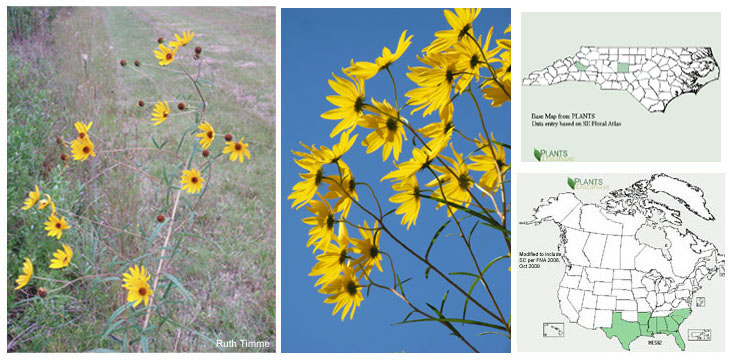

Helianthus simulans habit (Photo: Krings)

Helianthus simulans habit (Photo: Krings)

Helianthus simulans stem (Photo: Krings)

Helianthus simulans leaf (Photo: Krings)

Helianthus simulans (Photo: Krings)

Helianthus simulans flower (Photo: Krings)

Disc flowers of Helianthus simulans (Photo: Krings)
Helianthus simulans
(uncommon? [introduced]; roadsides, ditches; CP)


















